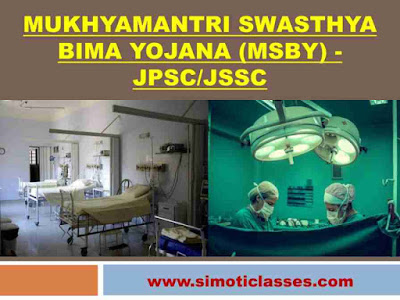Jharkhand Ki Shaikshanik Sansthan Part-3
(Educational Institutes Of Jharkhand)
प्राथमिक एवं माध्यमिक शिक्षा हेतु राज्य के उत्कृष्ट संस्थान
1. नेतरहाट विद्यालय
➤इसकी स्थापना 15 नवंबर 1954 को चालर्स नेपियर ने लातेहार में किया था।
➤इसमें नामांकन हेतु सरकारी विद्यालयों के विद्यार्थियों का प्रतियोगिता परीक्षा आयोजित किया जाता है तथा मेधा अंक के आधार पर दाखिला लिया जाता है।
➤यह राज्य का सर्वाधिक सम्मानित स्कूली संस्थान है।
2. सैनिक स्कूल तिलैया
➤1963 में कोडरमा जिले में इसकी स्थापना हुई।
➤इसका उद्देश्य छात्रों को रक्षा सेवा के लिए मानसिक एवं शारीरिक रूप से विकसित करना है।

प्राथमिक, माध्यमिक,एवं उच्चतर शिक्षा हेतु राज्य सरकार के प्रमुख कार्यक्रम
1. आवासीय विद्यालय योजना
➤आवासीय विद्यालय की स्थापना योजना के तहत नेतरहाट आवासीय विद्यालय एवं इंदिरा गांधी आवासीय विद्यालय की तरह दक्षिणी छोटानागपुर प्रमंडल, कोल्हान प्रमंडल एवं संथाल परगना में नये आवासीय विद्यालय की स्थापना की जाएगी।
➤इस आवासीय विद्यालय में पढ़ने वाले अनुसूचित जाति, जनजाति और पिछड़े वर्गों के छात्र/छात्राओं को निशुल्क शिक्षा के साथ सभी आवासीय सुविधाएं भी उपलब्ध कराई जा रही है।
➤वर्तमान में राज्य में 89 आदिवासी विद्यालय 23 अनुसूचित जनजाति के विद्यालय और 4 पिछड़ी जाति के आवासीय विद्यालय संचालित किए जा रहे हैं।
2. झारखंड बालिका आवासीय विद्यालय-योजना
➤इस योजना को अल्पसंख्यक समुदाय तथा बी.पी.एल के श्रेणी की छात्राओं में शिक्षा को प्रोत्साहित करने के लिए आरंभ किया गया है।
➤झारखंड बालिका आवास योजना में 75% विद्यार्थी अनुसूचित जाति एवं 25% विद्यार्थी अनुसूचित जनजाति तथा अल्पसंख्यक के होंगे। इसमें 25% आरक्षण गरीबी रेखा से नीचे जीवन-यापन करने वाले छात्राओं के लिए है।
➤यह योजना झारखंड शिक्षा परिषद परियोजना के माध्यम से संचालित होता है।
3. पहाड़िया दिवाकालीन विद्यालय
➤राज्य द्वारा यह विद्यालय 32 स्थानों पर कल्याण विभाग द्वारा संचालित किया जा रहा है।
➤इसका उद्देश्य पहाड़िया जनजाति के छात्रों में शिक्षा का विकास करना एवं जागरूकता फैलाना है।
➤साहिबगंज, दुमका, पाकुड़, गोड्डा आदि जिलों में विद्यालयों को चलाया जा रहा है।
4. ज्ञानोदय योजना
➤ज्ञानोदय योजना के तहत शिक्षा को गुणवत्तापूर्ण बनाने के लिए स्पोकन इंग्लिश/स्कूल लीडरशिप/मोटिवेशन/कंप्यूटर शिक्षा आदि में प्रशिक्षण कार्यक्रम चलाया जा रहा है।
➤इसके लिए ई-विद्यावाहिनी सॉफ्टवेयर तैयार किया गया है तथा 40,000 शिक्षकों को टेबलेट वितरित करना है।
➤इस योजना के द्वारा शिक्षकों और बच्चों की उपस्थिति, मध्यान्ह भोजन योजना इत्यादि पर भी नजर रखी जा सकेगी।
5. आश्रम या एकलव्य विद्यालय योजना
➤इसकी शुरुआत 2001 में की गई है। इस योजना का उद्देश्य अनुसूचित जनजाति के बच्चों को निशुल्क आवासीय प्राथमिक शिक्षा प्रदान करना है।
➤झारखंड में 71 एकलव्य विद्यालय प्रस्तावित है।
6. पुस्तक अधिकोष योजना
➤इस योजना के तहत तकनीकी शिक्षा में अध्ययनरत छात्रों को आर्थिक सहायता पुस्तक खरीदने हेतु दी जाती है।
➤मेडिकल, पॉलिटेक्निक, वेटनरी एवं एग्रीकल्चर महाविद्यालयों में अध्ययन करने वाले प्रति 2 छात्रों पर एक पुस्तक से उपलब्ध कराया जाता है।
7. साइकिल वितरण योजना
➤यह योजना ग्रामीण क्षेत्र की उन छात्राओं को शिक्षा को ध्यान में रखकर लागू की गई है, जो सुदूर ग्रामीण क्षेत्रों से पढ़ने आती थी।
➤अधिक दूरी और आर्थिक अभाव में यह लड़कियां पढ़ाई बीच में छोड़ देती थी। इसी को ध्यान में रखकर झारखंड सरकार ने नि:शुल्क साइकिल वितरण योजना लागू की है। इस योजना के तहत प्रत्येक छात्रा को ₹3500 साइकिल खरीदने हेतु दी जाती है।
8. कस्तूरबा गांधी बालिका विद्यालय योजना
➤इस योजना भारत सरकार के द्वारा 2004 शुरू की गई।
➤इस योजना का उद्देश्य, अनुसूचित जाति, जनजाति और पिछड़े वर्ग की बालिकाओं के लिए सुदूर ग्रामीण क्षेत्रों में आवासीय उच्च प्राथमिक विद्यालय की स्थापना करना है।
➤इस योजना के तहत शैक्षणिक रूप से पिछड़े 75% अनुसूचित जाति, जनजाति एवं पिछड़ी जाति की छात्राओं को आवासीय शिक्षा की सुविधा प्रदान करने के लिए 203 प्रखंडों में कस्तूरबा गांधी बालिका विद्यालय योजना संचालित की जा रही है।
9.मध्यान्ह भोजन योजना
➤इस योजना को 15 अगस्त, 1995 में केंद्र सरकार के द्वारा शुरू किया गया था।
➤इस योजना की सफलता को देखते हुए केंद्र सरकार ने वर्ष 2004 में इसे संपूर्ण भारत में सरकारी स्कूलों में लागू किया है। इस योजना के तहत कक्षा- 1 से 8 तक के सरकारी स्कूल के विद्यार्थियों को दोपहर का भोजन उपलब्ध कराया जाता है।इसमें केंद्र और राज्य सरकार का खर्च 75:25 के अनुपात में विभाजित है।
इस योजना का उद्देश्य है:-
(i) बच्चों का बेहतर विकास करना।
(ii) ज्यादा से ज्यादा बच्चे स्कूल आ सकें।
(iv) प्रभावित क्षेत्रों के बच्चों को खाना मुहैया कराना।
10. कंप्यूटर आधारित शिक्षा एवं साक्षरता
➤झारखंड सरकार के द्वारा माध्यमिक विद्यालयों में कंप्यूटर शिक्षा को प्राथमिकता दिया जा रहा है।
➤इस योजना को लगभग 1074 सरकारी माध्यमिक विद्यालयों में लागू किया जा रहा है।
➤इस योजना को राज्य सरकार ने जैव सूचना प्रौद्योगिकी अभिकर्त्ता को लागू करने के लिए चुना है।
11. मुख्यमंत्री विद्या-लक्ष्मी योजना
➤इस योजना के तहत कक्षा-6 से 9 तक के अनुसूचित जाति तथा अनुसूचित जनजाति के छात्रों की अपनी शिक्षा को आगे जारी रखने के लिए ₹2000 स्कॉलरशिप दी जाती है।
➤इस योजना का उद्देश्य, माध्यमिक विद्यालयों में जनजाति की छात्राओं के बीच शिक्षा तथा नामांकन दर में वृद्धि करना तथा विद्यालय को बीच में छोड़ने वाली छात्राओं की संख्या को कम करना है।
12. निःशुल्क पाठ्य पुस्तक वितरण योजना
➤झारखंड सरकार सर्व शिक्षा अभियान के तहत सरकारी स्कूल में पढ़ने वाले कक्षा-1 से 8 तक के पिछड़े वर्ग के विद्यार्थियों (ST, SC, OBC) को निशुल्क पाठ्य पुस्तक प्रदान करना है।
➤गरीबी रेखा से नीचे के विद्यार्थियों को मुफ्त में यूनिफार्म का वितरण भी जे. ई. पी. सी. के द्वारा किया जाता है।
13. साक्षर भारत मिशन
➤इसकी शुरुआत 8 दिसंबर, 2009 को अन्तराष्ट्रीय साक्षरता दिवस के अवसर पर किया गया।
➤यह केंद्र सरकार द्वारा वित्त पोषित योजना है।
➤झारखण्ड में इस योजना की शुरुआत 2010-11 में हुई।
14. सर्व शिक्षा अभियान
➤केंद्र सरकार ने 2003 में सर्व शिक्षा अभियान की शुरुआत की थी। जिसका उद्देश्य प्राथमिक शिक्षा के स्तर में सुधार लाना था।
➤वर्ष 2010 में सर्व शिक्षा अभियान का उद्देश्य संतोषजनक गुणवत्ता वाली प्राथमिक शिक्षा के सार्वभौमीकरण बनाया गया।
➤झारखंड सरकार ने शिक्षा के क्षेत्र में सुधार करने के लिए 6-14 वर्ष की आयु के बच्चों की प्राथमिक शिक्षा को निशुल्क और सशक्त बनाने के लिए, इस योजना को अपने राज्य में संचालित कर रही है।
➤इस योजना में केंद्र और राज्य सरकार का अनुपात 65:35 है।
➤इस योजना का उद्देश्य है।
(i) गुणवत्तापूर्ण प्राथमिक शिक्षा देना।
(ii) 0 से 14 वर्ष आयु के सभी बच्चों को 5 साल की प्राथमिक शिक्षा देना।
(iii) शिक्षा प्रणाली में स्थायी वित्त पोषक की व्यवस्था करना।




























